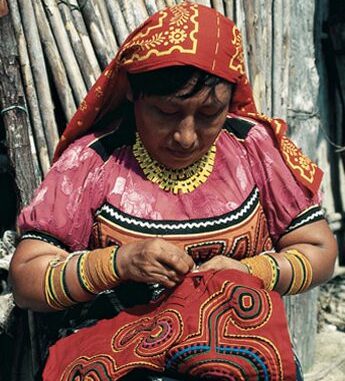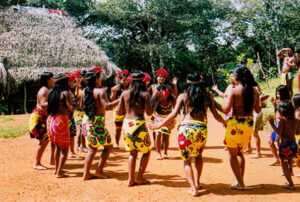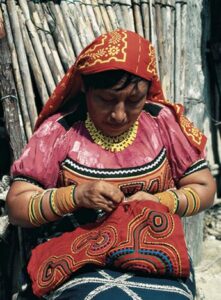
How many different indigenous groups would you guess live in Panama today? What language do they speak? Panama is home to seven distinct indigenous groups, each with its own unique language, history, culture, and customs. All of these groups strive to preserve their traditions, languages, values, connection with the Earth, and independence in the face of a growing modern industrialized world. Two of Panama’s major indigenous groups are the Emberá and the Guna. If you plan to visit any of these native peoples, brush up on your Spanish, because many of them speak Spanish as well as their native language.

Andrew Payti
Emberá women performing ceremonial dance
Emberá
Most of the Emberá live in the rain forests of the Darién region in southeastern Panama. Some Emberá, however, have migrated to Lake Bayano, and even farther to the Chagres River and Lake Alajuela in Chagres National Park. They live in thatched-roofed huts called bohíos, built on stilts to help protect them from flooding and wild animals. Emberá villages also have a casa comunal for official meetings and ceremonies. They grow gardens of herbs and plants for medicines, as well as vegetables and fruits for dyes. Most villages also have a school, although in the villages closer to cities, some children go to the city during the school year and return to their village when school is done. The Emberá live by hunting, fishing, and farming, and their main staples are fish, plantains and other fruits, coconuts, and root vegetables. During social gatherings and ceremonies, they perform music and dance, with movements inspired by animals. The Emberá make beautiful woven baskets from chunga palm and nahuala plant fibers, tiny delicate animal figures from tagua nuts, and fine wood carvings from the rich brown-red wood of the cocobolo tree. They also carve out tree trunks to make their piraguas, or canoes. While the Emberá still rely on the rivers of the Darién for travel, carrying cargo, and fishing, the Pan-American Highway has opened up this sparsely populated region to loggers, ranchers, and peasant farmers, threatening the indigenous population and the rain forest.

Barry Barker/McGraw-Hill Education
Guna woman sewing a mola, San Blas Islands
Guna
Most of the Guna people live in Guna Yala, the autonomous comarca, or indigenous territory, that comprises the San Blas Islands and a narrow strip of forest land along the Caribbean coast of Panama. The Guna also have small settlements in the rain forests of the Darién. Their livelihood depends on coconut harvesting, farming, fishing, handicrafts—especially the colorful molas for which they are well known— and tourism, which they limit and regulate. The San Blas Islands, with their soft white sand, turquoise waters, and coral reefs, offer a variety of activities and a relaxing view of nature, while at the same time tourists can experience the culture of the Guna people. Despite adapting to tourists and the modern world, the Guna have succeeded in preserving their traditional customs and ethnic identity through their organization, cohesiveness, and autonomy. They have the most advanced political system of any indigenous group in Latin America. A saila is both the political and spiritual leader of each village. Regular meetings are held in the casa comunal to discuss village matters. On a higher level, the Guna General Congress meets twice a year, bringing together representatives from all the villages in the comarca. The congress drafts legislation and manages numerous social and environmental projects. It also maintains an office in Panama City and actively negotiates with the Panamanian government on various issues.
Explore More:
Explore another indigenous group of Panama, or choose a topic that interests you about of one of these two groups to examine further, such as its language, schooling, government, economy, customs, relations with others, or art forms such as molas or baskets. Use this chart to help organize your research findings and to prepare a presentation for your Spanish or sociology class.